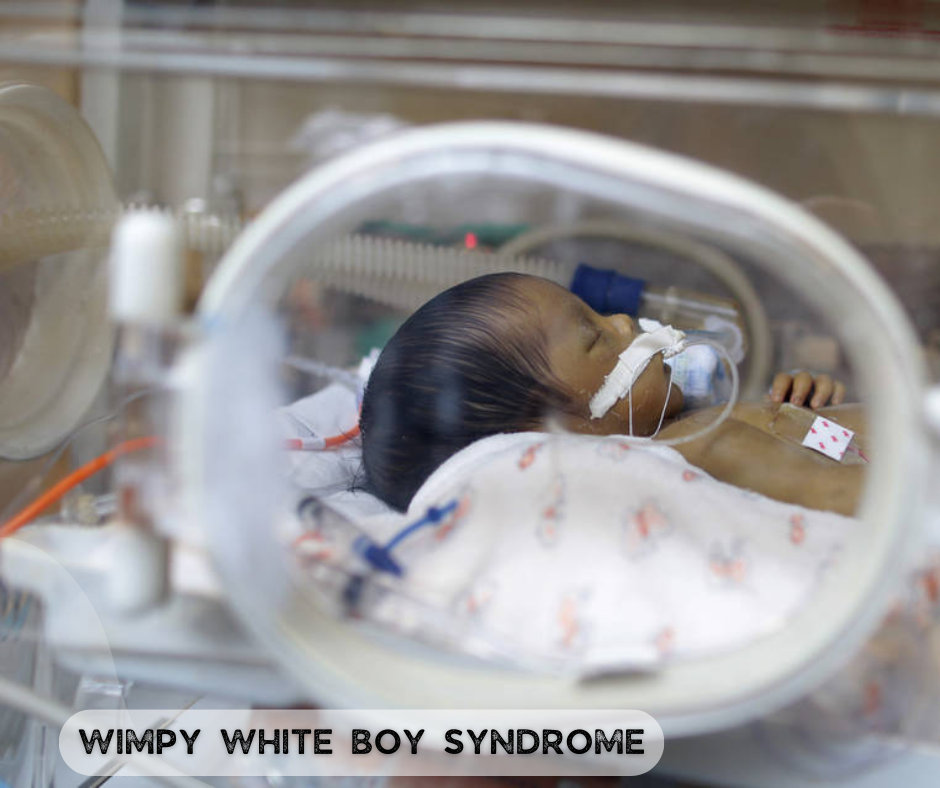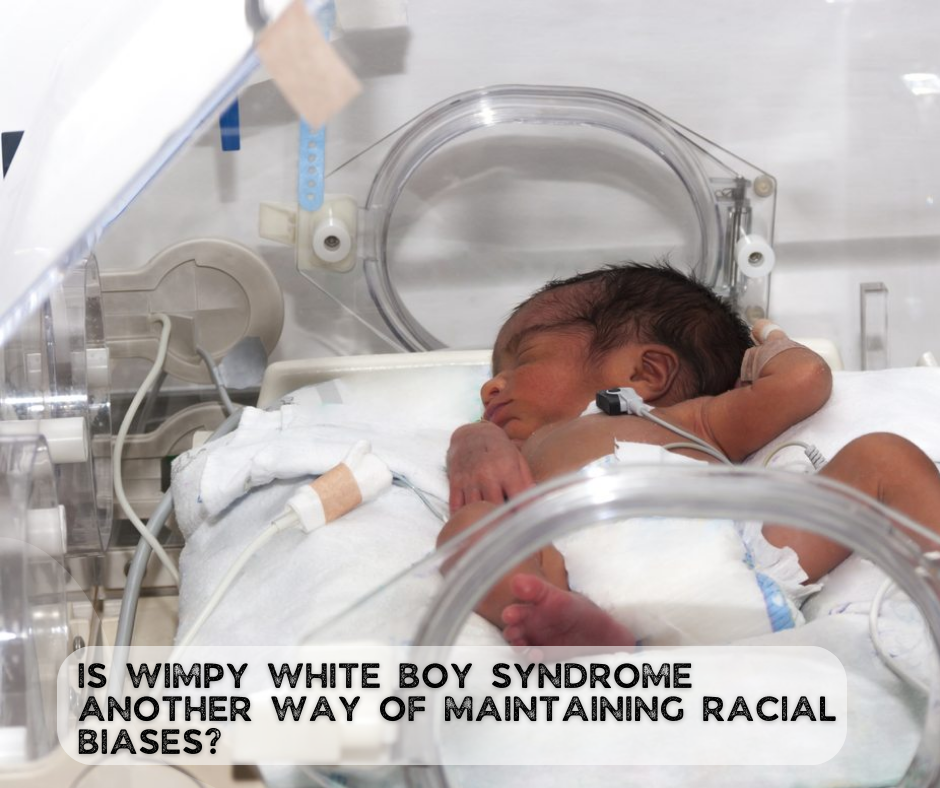In recent years, the medical community has made significant strides in understanding and treating various conditions affecting newborns. However, there remains a lingering issue surrounding the terminology used to describe certain conditions, particularly those that may carry racial connotations. One such term is “Wimpy White Boy Syndrome,” which has sparked controversy and raised questions about its legitimacy and implications. In this article, we delve into the background, definition, and myths surrounding Wimpy White Boy Syndrome while also exploring its broader implications and ways to address it.
Background of Wimpy White Boy Syndrome
Before delving into the definition of Wimpy White Boy Syndrome, it’s crucial to understand the context in which this term has emerged. Wimpy White Boy Syndrome refers to a condition observed in premature Caucasian male infants who experience breathing difficulties due to underdeveloped lungs at birth. These infants often require monitoring and care in the Neonatal Intensive Care Unit (NICU).
Understanding Wimpy White Boy Syndrome
Wimpy White Boy Syndrome is not a formal medical diagnosis but rather a colloquial term used to describe a set of symptoms experienced by premature Caucasian male infants. These symptoms include respiratory distress and difficulties in breathing, often resulting from underdeveloped lungs. While the term may be used by some clinical staff, it is essential to recognize that it lacks formal medical validation.
What is Wimpy White Boy Syndrome?
White boy syndrome is a term given to premature Caucasian white male babies because they face difficulty in breathing due to their underdeveloped lungs at the time of birth. Since their lungs do not function properly, they more often aspirate fluids into the lungs.

It has been found statistically that premature African American black female infants leave the NICU the fastest. But whatever the case, using a Caucasian boy white boi humiliation terminologies is another way of affixing to the mind that it’s common for them to spend a little longer in the NICU.
The clinical faculty of any specific hospital can use Wimpy white boy syndrome as a reason for the delay in treatment. Stay rest assured that white boy syndrome is not a formal diagnosis anyway. Often, the opposite happens when the breathing of the newborn infant normalizes within a week or two.
Debunking Myths and Misconceptions
One of the prevailing myths surrounding Wimpy White Boy Syndrome is the notion that it exclusively affects Caucasian male infants. However, studies have shown that premature infants of various ethnicities and genders may experience similar respiratory challenges. Therefore, it is crucial to avoid racial or gender-based assumptions when discussing neonatal health issues.
Exploring the Role of Race and Gender
The debate surrounding Wimpy White Boy Syndrome extends beyond medical circles, with sociologists questioning its implications and potential biases. Some clinicians have linked the syndrome with gender profiles, suggesting that male infants may be less robust during their early days. However, many neonatologists caution against attributing health outcomes to race or gender, emphasizing the need for individualized care based on clinical factors rather than non-modifiable identities.
Addressing Disparities in Care
Recent studies have shed light on disparities in neonatal care, particularly concerning minority infants. Research conducted by Stanford University School of Medicine has revealed significant disparities in the treatment of Latino and other minority infants compared to their Caucasian counterparts. These disparities highlight the need for greater awareness and advocacy to ensure equitable access to quality healthcare for all newborns.
Promoting Healthy Pregnancy and Birth
While the term Wimpy White Boy Syndrome may raise concerns, it’s essential to focus on promoting healthy pregnancies and reducing the risk of premature birth. Proper prenatal care, including regular check-ups and monitoring, can help identify and address potential risk factors early on. Additionally, maintaining a healthy lifestyle, including adequate nutrition and avoiding substance misuse, can contribute to healthier pregnancy and birth outcomes.
Is Wimpy White Boy Syndrome another way of maintaining racial biases?
The topic of Wimpy White Boy Syndrome has become a contested matter not only for medical researchers but sociologists who are also concerned about it.
Sociologists raised the question of whether the phenomenon is just a clinical concern or is misused for treating white infants better! Severe care disparity has been observed, according to researchers at Stanford University School of Medicine.

In contrast, they have studied more than 18,000 records of Californian-born babies who are treated in the NICU. Their study has found intense care disparity among the Latino and “other” infants from the white Caucasians. Here’s what the study has found-
- Not only in the childcare units, but overall, the medical profession addresses the patient’s problem differently than whites.
- Such systematic discrimination is based on the assumption that black people are subjected to less physical pain. Such assumptions are, in extreme cases, found grounded on the belief that earlier medical experiments were carried forward on African slaves and immigrants were denied medical care even though how they had survived severities. Such systematic racial biases are then transferred to the babies.
- The Stanford study also found premature black newborns getting lesser steroid therapy for the development of the lungs. They don’t even arrange retinopathy for prematurity in a timely manner.
Whatever the cases, such justified bias in the medical sector often leads to long-term consequences for black infants. They were not fed at the proper time, and often infections occur because of careless hospital treatment of Latinos and Asians than whites.
Further, many hospitals also undergo unofficial diagnostic for WWBS, which complicates even white boys’ health.
Precautions to avoid premature birth
To avoid panicking, the concern for an expecting mom should not be about their racial affinities, but instead, they should focus on a healthy gestation period. Usually, a full-term pregnancy period happens to be for thirty-eight to forty weeks.
Delivering before the completion of 40 weeks can be risky for your baby’s health regardless of whether they are black, white, Latino, etc. In case of premature delivery, organs like lungs, liver, and brain fail to develop fully.
Here are some of the preventive measures to avoid premature birth-
1. Proper prenatal care
Proper prenatal care is mandatory when you already have a history of miscarriage or premature delivery. Regularly visit the doctor’s clinic to check your baby’s growth and position in the womb.
Other than that, if you have issues with your cervix or uterus or have past experiences with irregular menstruation, then be careful.
2. Don’t overdose on the medicated drugs
Stay extra cautious about the dosage of the drugs that your gynecologist has prescribed you. Overdosage of drugs can have chemical reactions in your body and is not safe for new ones. Besides all, avoid consuming street drugs or misuse prescription drugs.
3. Maintain healthy body weight
It’s essential to maintain a healthy body weight proportionate to your height. Both extreme cases of obesity and underweight are not healthy for safely delivering your child. You can do light yoga and exercise to maintain your physical and mental fitness.
4. An adequate supply of nutrients to the body
Make sure that you eat healthy green leafy vegetables and fruits adequately. In most cases, you would be required to eat extra nutritious food to ensure the healthy growth of your unborn fetus.
One of the primary reasons for the delivery of premature babies is the lack of a proper supply of nutrition during the gestation period. So, to deliver a healthy baby, eat what your body demands.
Is wimpy white boy syndrome real?
Because the parameters to judge the practicality of Wimpy White Boy Syndrome are not set satisfactorily, it would not be easy to comment on the truth behind WWBS’ claims.
Basically, it remained a tug of war between statistics and official diagnostics, due to which no proper medical theory can be developed, even though some statistics show that white boys are diagnosed with respiratory ailments due to uneven lung development.
Still, such a view can become highly racist or offensive. Even the parents of newborn white boys often get psychologically affected by the claim of such unchangeable syndromes.
In upcoming years, the question of whether WWBS is a legitimate medical issue or another way of practicing systematic racial and gender bias among NICUs will still worry medical researchers.
Conclusion
In conclusion, Wimpy White Boy Syndrome represents a complex issue that extends beyond medical diagnosis to encompass broader societal implications and disparities in healthcare. By raising awareness, challenging myths, and advocating for equitable care, we can work towards ensuring better outcomes for all newborns, regardless of race or gender. Together, we can overcome Wimpy White Boy Syndrome and promote a healthier future for our children.
Frequently Asked Questions (FAQs) about Wimpy white Boy Syndrome
Q. What is Wimpy white Boy Syndrome?
Answer- Wimpy white boy Syndrome is often found in the NICU childcare units. The Syndrome is based on the assumption that Caucasian white boys are the last ones to leave the NIC units because of their weak lungs and premature health conditions as compared to other racial and gender groupings. African female babies are assumed to go to the NICUs the fastest.
Q. Is Wimpy white Boy Syndrome formally diagnosed?
Answer— To this date, white boy syndrome has not been formally diagnosed by the medical field. Such syndromes have no formal diagnosis, like jaundice or other ailments. White Boy syndrome, if legitimate, is based on statistics and not on any official medical genealogy.
References-
- CDC – Racial and Ethnic Disparities in Infant Mortality
- Mayo Clinic – Premature Birth: Symptoms and Causes
- Healthline – Premature Babies: Common Complications
